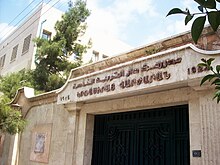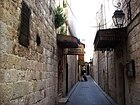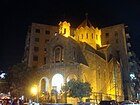Armenians in Syria
The Armenians in Syria are Syrian citizens with either partial or total Armenian descent. Syria and surrounding areas have often served as refuge for Armenians fleeing wars and persecution such as the Great Genocide . At the beginning of the Syrian Civil War, around 150 to 190 thousand people of Armenian origin lived in Syria, the majority in the city of Aleppo , as well as in Damascus and Qamishli and in the predominantly Armenian towns of Kessab and Yacoubeh . However, due to the policy of Arabization , the Armenian population in Syria fell over the past 20 years and was still 100,000 in 2010. Most of them therefore speak mostly Syriac Arabic alongside Western Armenian today . The most widespread religions are the Armenian Apostolic , Armenian Catholic and Armenian Evangelical Churches . Their current number is unknown, but between 2011 and 2017 22,500 Armenian refugees from Syria were registered in Armenia alone .
history
When the Seljuk Turks forcibly conquered historic Armenia from their Byzantine rulers from the 11th century onwards , a stream of Armenians had to leave their homeland to find a safe place to live. Most Armenians built a new refuge in Cilicia , where an Armenian kingdom was established, but many also chose northern Syria. Armenian quarters were formed in cities like Antioch , Aleppo, and Aintab .
During the Crusades , the Armenian Kingdom of Cilicia chose to side with the European conquerors rather than the predominantly Turkish rulers of Syria. Before the siege of Antioch , most of the Armenians were driven out by Yaghi-Siyan , the Turkish governor of the city, whereupon the remaining Armenians of Antioch increased their support for the crusaders. Hence the new rulers of Antioch became Europeans. Armenian craftsmen and engineers helped the crusaders during the siege of Tire by manipulating siege equipment.
Even after the 12th century there were many Armenian villages in this region. Almost all of them were Arabized and Islamized , with the exception of three places: Yacoubeh (al-Yaʿqūbiyya), Kessab (Kasab), and Ghinemieh .
Deir ez-Zor and the genocide

Although the Armenians had a long history in Syria, most of them came during the Armenian Genocide perpetrated by the Ottoman Empire . The most important killing fields of the Armenians were in the Syrian desert of the Deir ez-Zor region ( Euphrates valley). Up to 1.5 million Armenians were killed here and hundreds of thousands fled to historic Armenia or abroad, especially to the New World , Europe and Lebanon . The local Syrian Arabs often did not hesitate to give shelter to the persecuted Armenians and to support them.
In 1915 the Syrian Deir ez-Zor (Der Zor), mainly desert area, became the final destination of the Armenians during the genocide, where they were also killed. A memorial complex commemorating this tragedy has been opened in the city. It was designed by Sarkis Balmanoukian and officially inaugurated in 1990 in the presence of the Armenian Catholicos of the Great House of Cilicia. The complex contains bones and remains of the Armenian victims of the genocide who were rediscovered in the Deir-ez-Zor desert and has become a pilgrimage destination for the Armenian diaspora in memory of their deaths. However, on September 21, 2014, it was destroyed by Islamists in the Syrian civil war.
Armenians in independent Syria
With the rise of Arab nationalism and Islamism , thousands of Armenians left Syria for France , the United States , Canada and Australia . After the Second World War, the government of the Armenian Soviet Socialist Republic carried out a campaign to persuade Diaspora Armenians to move to Soviet Armenia. Thousands of Armenians resettled from Syria to Armenia, including the family of the later Armenian President Levon Ter-Petrosyan (* 1945 in Aleppo). Most of them spoke at least one other language besides Armenian, usually Arabic or French, and had a good education.
Most of Syria's Armenians live in Aleppo - around 60,000 in Aleppo around 2010 out of a total of around 100,000 in Syria - while a smaller community resides in the capital Damascus . Armenians have their own quarter "Hayy al Arman" (quarter of the Armenians) in Damascus. Armenians also live in the cities of Latakia , Kesab and Yacoubeh (al-Yaʿqūbiyya) in the northwest, and in ar-Raqqah , Tell Abyad , al-Hasakah , Qamishli , Malikiya and Raʾs al-ʿAin in the east.
Under the Syrian government of the nationalist Bashar al-Assad - as under his father Hafiz al-Assad - the Christians of Syria and thus also the ethnic Armenians within the framework of Arab nationalism , a counter-movement to pan-Islamism , were largely equal. In the parliamentary elections in Syria in 2016 , two Syrian Armenians won a mandate. One of them is the historian Nora Arissian , with whom an Armenian woman was elected member of parliament for the first time in the history of Syria.
Armenians in the Syrian Civil War
When the Syrian civil war began in 2011, most Armenians tried to stay out of Syria, but trusted in the victory of the Assad government. With the increasing attacks by Islamist forces on Christians, the reluctance turned into open support for the Syrian government by almost all Syrian Armenians.

With the increasing success of the Islamists in the civil war, including the conquest of the Armenian village al-Yaʿqūbiyya on the Turkish border and the eastern districts of Aleppo, more and more Syrian Armenians were forced to flee. Many found refuge in the port city of Latakia , some in Kessab, while others fled to Beirut or other cities in Lebanon . However, on March 24, 2014, Kessab was also captured by Islamists of the al-Nusra Front , an offshoot of al-Qaeda , with logistical support from Turkey and, after almost all residents had fled, looted, churches and schools in some cases badly damaged. Although Kessab made up only a small proportion of the Syrian Armenians with about 4000 inhabitants, it has great symbolic significance for the Armenian Diaspora as a place of continuous Armenian settlement since the Middle Ages, which had already witnessed massacres and genocide twice by Turks, and the fall of the town sparked a major campaign on social media and with demonstrations to save the town (Save Kessab) . Kessab was liberated on June 15, 2014, with the Syrian army also receiving support from Armenian vigilante groups and Hezbollah units. The following day about 250 of the 600 families who had fled returned to Kessab. Even more, however, the victory over the Islamists in Aleppo at Christmas 2016 was greeted with relief by the Armenians, which led to an approximate cessation of the flow of refugees to Armenia. Many buildings were destroyed in the war; For example, the reconstruction of the Armenian Forty Martyrs Cathedral in Aleppo, which began in 2017 , of which only the church tower remained intact, took around two years; it finally reopened on March 30, 2019.
Escape and return
The escape routes of the Syrian Armenians differ significantly from those of the Muslim refugees: Hardly any Armenian came to Europe via Turkey and the Mediterranean. From the beginning of the civil war to the beginning of 2017, shortly after the liberation of Aleppo, the Republic of Armenia registered around 22,500 Armenian-Syrian refugees. Members of the Armenian diaspora receive an Armenian passport, and since 2007 Armenia has allowed dual citizenship . However, the Armenian-Syrian refugees in Armenia are confronted with a severe deterioration in their standard of living compared to the pre-war period in Syria. For example, a hairdresser who immigrated from Syria in Yerevan earns 200 euros a month, while in Aleppo before 2011 he earned around 50 euros a day. That is why many of these refugees are thinking about moving to Europe or North America. Another problem for the Syrian Armenians in Armenia is that they first have to learn Eastern Armenian , which is difficult for the Western Armenian- speaking refugees to understand. With the expulsion of the Islamists from Kessab and Aleppo, hopes are growing again that Armenian-Syrian refugees will return to their homes in Syria. Some Armenian refugees have since returned, including from Armenia and even from Europe and North America to Aleppo, where, for example, the Armenian Karen Yeppe College , which once had 1200 students - located on the former battle line - will resume classes in autumn 2017 with 400 boys and girls could. It is the churches in Syria in particular, including the Armenian Evangelical Church , who want to convince the Armenian and other Christians to stay in Syria or to return to Syria.
media
Syria has a rich tradition of media and publications in the Armenian language . Armenian daily newspapers, which no longer exist, had very large circulations for the small Armenian population. The daily Hay Tsayn (1918–1919), the bi- day Darakir (1918–1919) and Yeprad (1919) were among the first published newspapers in Syria. A wave of publications followed in the twenties and thirties : Suryagan Surhantag (1919–1922), Suryagan Mamul (1922–1927), the daily Yeprad (1927–1947), Surya (1946–1960) and Arevelk (1946–1963) .
Syrian editors make a great contribution to the translation of a wide variety of Armenian literature and academic studies into Arabic . It is worth noting that the first Arabic-language newspaper was published in Constantinople in 1855 by the Aleppine journalist Rizqallah Hassoun .
gallery
Armenian Catholic Holy Cross Church , Aleppo
literature
- Nicola Migliorino: Constructing Armenia in Lebanon and Syria: Ethno-Cultural Diversity . Berghahn Books, New York 2008.
Individual evidence
- ↑ Yakoubiye in The Armenian Prelacy of Aleppo ( Memento of December 25, 2013 Internet Archive )
- ^ Monument and Memorial Complex at Der Zor, Syria
- ^ The jihadists of the Islamic State destroy the memorial church of the Armenian Genocide in Deir el-Zor. Fides Service , accessed March 24, 2015 .
- ↑ a b c Armenian minority in Syria. Aleppo, tragic beauty. The daily newspaper , May 16, 2016.
- ↑ a b Armenian community flees Syria. Escape to the impoverished brothers. The daily newspaper , August 21, 2012.
- ↑ Gerrit Hoekman: Rubbed on all fronts. Syria: Al-Nusra Front increasingly weakened. Hasty retreat from the small town of Kassab. Young World , June 21, 2014.
- ^ Valeriy Melnikov: Les Arméniens de Syrie survivent en défiant le terrorisme. Sputniknews, January 16, 2016.
- ↑ a b c Flow of Syrian Armenians to Armenia sharply decreases after Aleppo liberation. Armenpress, September 16, 2017.
- ^ Ancient Armenian church being restored in Aleppo. Armenia News, July 12, 2017.
- ^ A b Jonathan Steele: Return to Aleppo: 'I never expected such destruction'. Middle East Eye, October 4, 2017.
- ^ Catholicos of Great See of Cilicia Aram I Consecrates Forty Martyrs Cathedral in Aleppo. The Armenian Mirror-Spectator, April 4, 2019.
- ↑ Refugees in Armenia - Little Hope for Better Times. The South Caucasus republic accepts refugees from the Syrian diaspora. But many want to leave the country for Europe. The daily newspaper , November 11, 2015.
- ^ Armenian MP of Syria: Armenians are returning to Aleppo, even from Europe and North America. NEWS.am, September 22nd 2017.
- ↑ "Encourage Syrian Christians Not to Go to Europe". Harout Selimian is President of the Armenian Evangelical Church in Syria and Pastor of the Bethel Church in Aleppo. In an interview he talks about the life of Christians in Aleppo and reconciliation in Syria (in an interview with Lukas Reineck). Pro-Medienmagazin, July 19, 2017 ( Syria: How do Christians live in Aleppo now ? , Spiegel on the side of the Evangelical Alliance ).
- ↑ The Syrian press, the past and the present, by Hashem Osman, 1970 Damascus (الصحافة السورية ماضيها وحاضرها –هاشم عثمان– 1970 دمشق)







